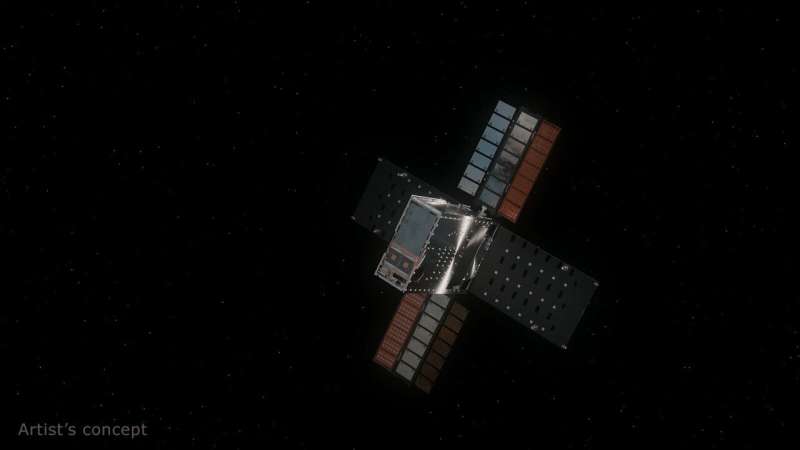This article has been reviewed according to Science X's editorial process and policies. Editors have highlighted the following attributes while ensuring the content's credibility:
fact-checked
trusted source
proofread
NASA calls end to Lunar Flashlight mission after some tech successes

While the CubeSat couldn't reach the lunar South Pole to help seek ice, it fulfilled several technology goals that will empower future missions for the benefit of humanity.
NASA's Lunar Flashlight launched on Dec. 11, 2022, to demonstrate several new technologies, with an ultimate goal to seek out surface ice in the permanently shadowed craters of the moon's South Pole. Since then, the briefcase-size satellite's miniaturized propulsion system—the first of its kind ever flown—proved unable to generate enough thrust to get into lunar orbit, despite months of effort by the operations team. Because the CubeSat cannot complete maneuvers to stay in the Earth-moon system, NASA has called an end to the mission.
NASA relies on technology demonstrations to fill specific knowledge gaps and to test new technologies. Used for the first time beyond Earth's orbit, Lunar Flashlight's propulsion system and green fuel were such demonstrations. Although the propulsion system was unable to produce the desired thrust—likely because of debris buildup in the thruster fuel lines—newly developed propulsion system components exceeded performance expectations.
Also surpassing expectations were Lunar Flashlight's never-before-flown Sphinx flight computer—a low-power computer developed by NASA's Jet Propulsion Laboratory in Southern California to withstand the radiation of deep space—and the spacecraft's upgraded Iris radio. Featuring a new precision navigation capability, the radio can be used by future small spacecraft to rendezvous and land on solar system bodies.
"Technology demonstrations are, by their nature, higher risk and high reward, and they're essential for NASA to test and learn," said Christopher Baker, program executive for Small Spacecraft Technology in the Space Technology Mission Directorate at NASA Headquarters in Washington. "Lunar Flashlight was highly successful from the standpoint of being a testbed for new systems that had never flown in space before. Those systems, and the lessons Lunar Flashlight taught us, will be used for future missions."
The mission's miniaturized four-laser reflectometer, a science instrument that had never flown before, either, also tested successfully, giving the mission's science team confidence that the laser would have been able to detect ice if it were present at the lunar surface.
"It's disappointing for the science team, and for the whole Lunar Flashlight team, that we won't be able to use our laser reflectometer to make measurements at the moon," said Barbara Cohen, the mission's principal investigator at NASA's Goddard Space Flight Center in Greenbelt, Maryland. "But like all the other systems, we collected a lot of in-flight performance data on the instrument that will be incredibly valuable to future iterations of this technique."
Propulsion system performance challenges
Despite the mission's technological wins, Lunar Flashlight's miniaturized propulsion system struggled to provide sufficient thrust to put the CubeSat on course for the planned near-rectilinear halo orbit that would have given the spacecraft weekly flybys of the moon's South Pole.
The team suspects that debris obstructed the fuel lines, causing the diminished and inconsistent thrust. The miniaturized propulsion system included an additively manufactured fuel feed system that likely developed the debris—such as metal powder or shavings—and obstructed fuel flow to the thrusters, limiting their performance. Although the team devised a creative method for using just one thruster to maneuver the spacecraft, Lunar Flashlight needed more consistent thrust to reach its planned orbit.
The operations team calculated a new orbit that could be reached using the spacecraft's small amount of potential remaining thrust. The plan called for putting the CubeSat on a path that would place it in orbit around Earth rather than the moon, with monthly flybys of the lunar South Pole. While this would have meant fewer flybys, the spacecraft would have flown closer to the surface.
With the mission running out of time to arrive at the needed orbit, the operations team tried to dislodge any debris from the fuel lines by increasing the fuel pressure well beyond the propulsion system's designed capacity. Despite limited success, the required trajectory correction maneuvers couldn't be completed in time.
"The student operations team at Georgia Tech, with assistance from JPL and NASA's Marshall Space Flight Center, rose to the challenge and came up with an incredible array of inventive techniques to utilize what tiny amount of thrust Lunar Flashlight's propulsion system could deliver," said John Baker, Lunar Flashlight project manager at JPL. "We learned a lot and honed new methods and strategies for working with tiny spacecraft."
After having traveled out past the moon, Lunar Flashlight is now moving back toward Earth and will fly past our planet with a close approach of about 40,000 miles (65,000 kilometers) on May 17. The CubeSat will then continue into deep space and orbit the sun. It continues to communicate with mission operators, and NASA is weighing options for the future of the spacecraft.
Provided by NASA




















